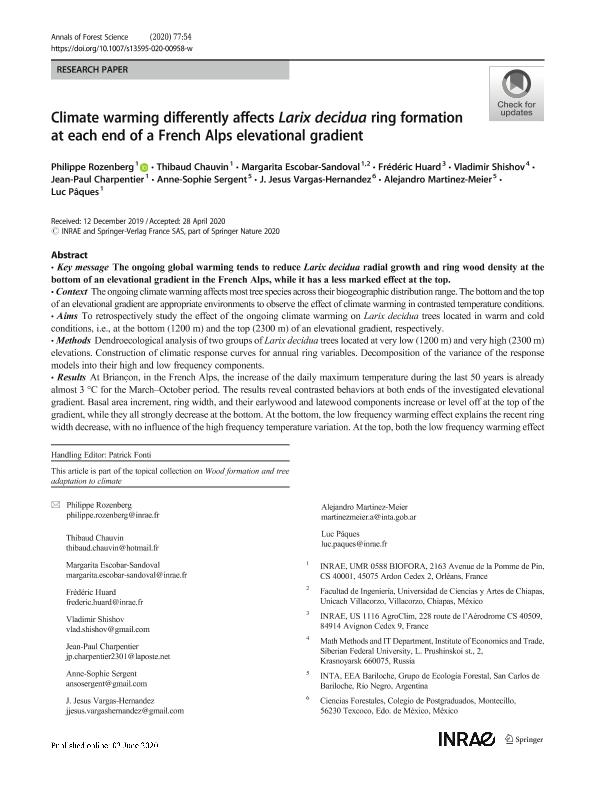Artículo
Climate warming differently affects Larix decidua ring formation at each end of a French Alps elevational gradient
Rozenberg, Philippe; Chauvin, Thibaud; Escobar Sandoval, Margarita; Huard, Frédéric; Shishov, Vladimir; Charpentier, Jean Paul; Sergent, Anne Sophie ; Vargas Hernandez, J. Jesus; Martinez Meier, Alejandro; Pâques, Luc
; Vargas Hernandez, J. Jesus; Martinez Meier, Alejandro; Pâques, Luc
 ; Vargas Hernandez, J. Jesus; Martinez Meier, Alejandro; Pâques, Luc
; Vargas Hernandez, J. Jesus; Martinez Meier, Alejandro; Pâques, Luc
Fecha de publicación:
06/2020
Editorial:
EDP Sciences
Revista:
Annals of Forest Science
ISSN:
1286-4560
e-ISSN:
1297-966X
Idioma:
Inglés
Tipo de recurso:
Artículo publicado
Clasificación temática:
Resumen
The ongoing climate warming affects most tree species across their biogeographic distribution range. The bottom and the top of an elevational gradient are appropriate environments to observe the effect of climate warming in contrasted temperature conditions.AimsTo retrospectively study the effect of the ongoing climate warming on Larix decidua trees located in warm and cold conditions, i.e., at the bottom (1200 m) and the top (2300 m) of an elevational gradient, respectively.MethodsDendroecological analysis of two groups of Larix decidua trees located at very low (1200 m) and very high (2300 m) elevations. Construction of climatic response curves for annual ring variables. Decomposition of the variance of the response models into their high and low frequency components.ResultsAt Briançon, in the French Alps, the increase of the daily maximum temperature during the last 50 years is already almost 3 °C for the March?October period. The results reveal contrasted behaviors at both ends of the investigated elevational gradient. Basal area increment, ring width, and their earlywood and latewood components increase or level off at the top of the gradient, while they all strongly decrease at the bottom. At the bottom, the low frequency warming effect explains the recent ring width decrease, with no influence of the high frequency temperature variation. At the top, both the low frequency warming effect and the high frequency temperature effect explain each about half of the ring width variation encompassed by the model. Latewood density displays the same trend as ring width, while earlywood density decreases at both ends of the gradient.ConclusionSuch opposed trends of the radial growth time trends between the top (2300 m) and the bottom (1200 m) of the gradient reflects the respectively favorable and unfavorable effects of climate warming at such ends of this Larix decidua elevational gradient. We propose that the strong ring width decrease observed at the warmer bottom announces a coming dieback. The corresponding wood density decrease will affect wood hydraulic properties in a way that is unclear.
Palabras clave:
CLIMATE WARMING
,
ELEVATIONAL GRADIENT
,
LARIX DECIDUA
Archivos asociados
Licencia
Identificadores
Colecciones
Articulos (IFAB)
Articulos de INSTITUTO DE INVESTIGACIONES FORESTALES Y AGROPECUARIAS BARILOCHE
Articulos de INSTITUTO DE INVESTIGACIONES FORESTALES Y AGROPECUARIAS BARILOCHE
Citación
Rozenberg, Philippe; Chauvin, Thibaud; Escobar Sandoval, Margarita; Huard, Frédéric; Shishov, Vladimir; et al.; Climate warming differently affects Larix decidua ring formation at each end of a French Alps elevational gradient; EDP Sciences; Annals of Forest Science; 77; 2; 6-2020; 1-20
Compartir
Altmétricas



